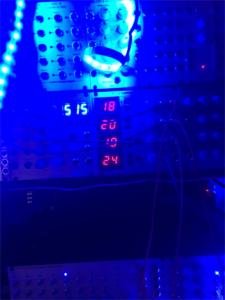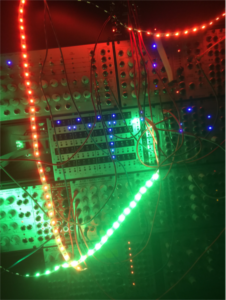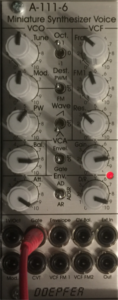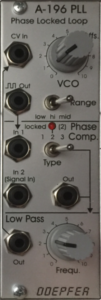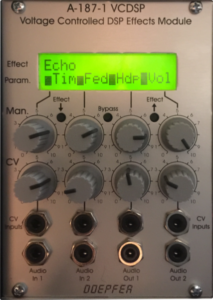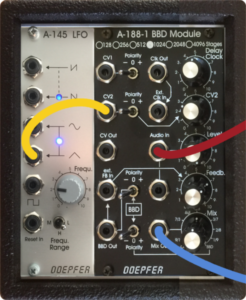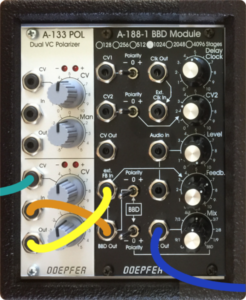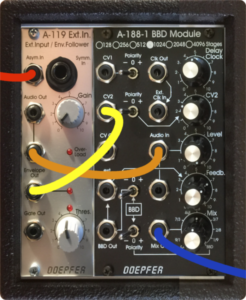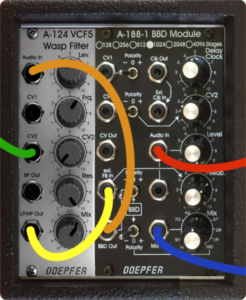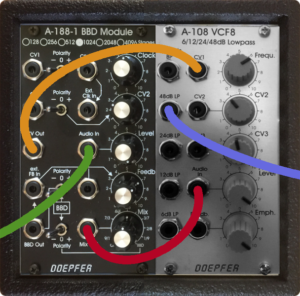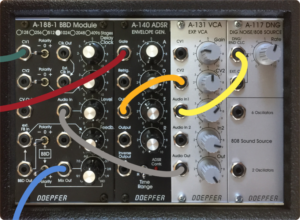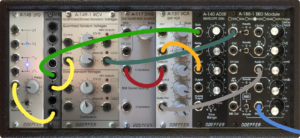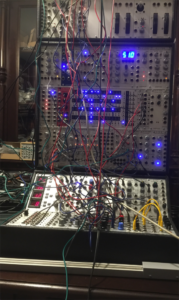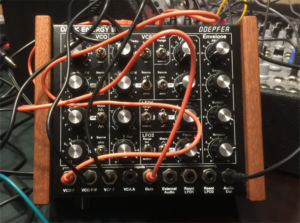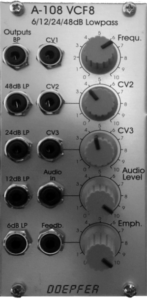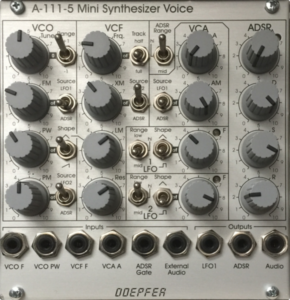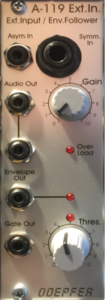Category Archives: Doepfer
A-113 Subharmonic Generator
A-157 Trigger Sequencer Subsystem
A-111-6 Miniature Synthesizer Voice
A-196 PLL Phase Locked Loop
A-187-1 VCDSP – Voltage Controlled DSP Effects Module
A-188-1: Doepfer Patches
A-100: Drone
Dark Energy III
A-100
A-100
“In the A-100, Doepfer have produced a capable and versatile analog modular synthesizer, built in the style of the classic modular systems of the seventies. The renaissance of analog synthesis in the last few years shows that analog sound production has a vital place alongside sampling and digital synthesis, and can produce sounds that are unobtainable by any other means. In addition to the unique sounds of its oscillators, filters, amplifiers, phasers, frequency shifters, and so on, analog synthesis can provide almost unbounded modulation opportunities, conventional and unconventional – limited only by the number and variety of modules available.
In designing the A-100, our priorities were: good sound quality; diversity of modules available; ease of integration into a MIDI system; and, maybe most important of all, affordability.
A-105 VCF – SSM 24dB Low Pass
A-105 VCF
SSM 24dB Low Pass
“Module A-105 is another voltage-controlled low-pass filter with 24dB/octave slope. The A-105 is very similar to the A-122 that is made with a CEM chip. But in contrast to the A-122 the A-105 is made with the legendary SSM filter chip SSM2044. This chip was used e.g. in these synthesizers: Korg Polysix, Korg Mono/Poly, Fairlight II, PPG Wave 2.2 und 2.3, Emu SP-1200, Siel DK600, Siel Opera 6. The first Prophets used the SSM2040 – the precedessor of the 2044 – that generates a very similar sound. The special feature of the 4 pole low pass SSM2044 is the patented so-called “true open loop design that delivers a characteristic fat sound not available from other devices” (extract from SSM2044 data sheet). The module will feature voltage controlled resonance and a sensitve audio input to obtain distortion – if desired. Regarding to the functions, controls and in/outputs the module is identical to the 24dB low pass filter A-122 that is built around a CEM chip. But the sound, the resonance behaviour and the distortion behaviour are completely different for both modules.”
A-108 VCF8 – 6/12/24/48 dB Lowpass
A-108 VCF8
6/12/24/48 dB Lowpass
“Module A-108 is a completely new voltage-controlled low pass pass filter based on the well-known transistor ladder (Moog ladder). The module has internally an 8 stage low pass filter with different slopes available: 6, 12, 18, 24, 30, 36, 42 and 48 dB per octave. In addition it features an band pass output (i.e. band pass with transistor ladder). In the factory the 4 low pass outputs of the A-108 are internally connected to the filter stages 6, 12, 24 and 48dB. From our first A-108 audio tests this seems to be the best output combination as these outputs generate audible different sounds. E.g. the audible difference between the 48dB and 42dB or between 42dB and 36dB is very little. But if desired any of the filter stages can be connected to one of the outputs. Continue reading A-108 VCF8 – 6/12/24/48 dB Lowpass
A-111-5 Mini Synthesizer Voice
A-111-5
Mini Synthesizer Voice
“Module A-111-5 is a complete monophonic synthesizer module that includes these components (modular version of Dark Energy):
VCO
manual tune control (with an internal jumper the range can be set to ~ +/-1 half an octave or ~ +/-2.5 octaves)
range switch -1 / 0 / +1 octave
frequency range about 10Hz … 12kHz
FM (frequency modulation) control with modulation source switch (LFO1 / off / ADSR)
manual pulsewidth control for rectangle waveform
PWM control with modulation source switch (LFO2 / off / ADSR)
waveform switch (sawtooth / off / triangle)
the sum of the waveform chosen by this switch and the rectangle is fed into the VCF (to turn the rectangle off the PW control has to be set fully CCW)
external CV input for VCO frequency (1V/octave)
external CV input for external PWM of the rectangle
internal CV input for frequency (1V/octave) connected to the A-100 bus via jumper, the jumper can be used to interrupt this internal connection if not wanted Continue reading A-111-5 Mini Synthesizer Voice
A-119 Ext. In. – Ext. Input / Env. Follower
A-119 Ext. In.
Ext. Input / Env. Follower
“Module A-119 (External Input / Envelope Follower) is designed to allow external audio signals to be integrated into the System A-100. It comprises a pre-amp, envelope follower, and comparator.
The pre-amp has two inputs: an unbalanced input for line level signals, with a gain factor of from 0 to 20, and a balanced input with a gain factor of from 0 to 500, for insertion of low level signals, for instance from a microphone or electric guitar.
The Envelope Follower reads the signal level of the input, and puts out a proportional voltage as an envelope at its own output.
The comparator generates a gate signal whenever the input goes above an adjustable trigger threshold.
Three LEDs help you keep track of overload, the envelope, and the gate signal.”
A-145 LFO
A-145 LFO
“Module A-145-1 is a low frequency oscillator, which produces cyclical control voltages in a very wide range of frequencies. Five waveforms are available: sawtooth, inverted sawtooth, triangle, sine and square wave.
The LFO can be used as a modulation source for any number of modules – for instance modulating the pulse width or frequency of a VCO, modulation of the cut-off frequency of a VCF, or amplitude modulation with a VCA.
A three-way switch lets you select three frequency ranges, spanning from one cycle every several minutes at the lowest, to moderate audio frequency at the highest (about 4-5 kHz).
The LFO signal can also be synchronised, via the reset input.
Typical frequency ranges depending upon the position of the Frequ. Range switch:
H: about 10Hz – 4.5kHz
M: about 0.1Hz (10 seconds period) – 50Hz
L: about 0.005 Hz (3.5 minutes period) – 5Hz”
